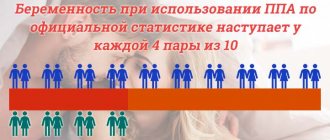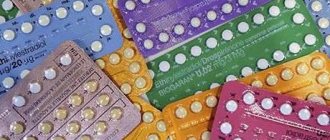Phases of the menstrual cycle
Every month, women produce bloody discharge lasting 3-7 days - menstruation. They are secreted from the endometrium of the uterus in the form of blood and exit the vagina through the cervix.
When released, the fluid is dark red, pink or brownish in color. Bleeding begins in girls at the age of 10-12 and lasts until 46-51 in women before menopause and gradual loss of fertility.
The menstrual cycle statistically lasts 28 days, but can vary from 21 to 35 days.
There are phases:
- Follicular. The beginning of a new menstrual cycle. The phase lasts from 7 to 21 days. The hormone estrogen, which affects the endometrium, provokes the growth of the uterine layer, preparing it for the attachment of a fertilized egg if pregnancy occurs. Follicle-stimulating hormone stimulates the growth of ovarian follicles containing eggs. 4-6 follicles mature, but only one will remain active at the end of the phase. Thanks to luteinizing hormone, the follicle will break through and the egg will be released, ovulation will occur.
- Ovulatory. Ovulation is the stage of release of a mature prepared egg from the ovarian follicle into the fallopian tube and then into the uterus. Ovulation occurs 12-15 days before the next menstruation and lasts 1-4 days. Exactly as long as the egg is suitable for fertilization. If pregnancy does not occur, the egg degenerates.
- Luteal. The final stage or corpus luteum stage. Duration 12-13 days. After the egg is released, the ruptured follicle becomes the corpus luteum, a gland that produces progesterone, which prepares the uterus for pregnancy. During the phase, body temperature rises to 38 degrees. A nutritious secretion is produced that promotes the development of the embryo, the level of progesterone and estrogen increases, dilating the ducts of the mammary glands. If pregnancy does not occur, the corpus luteum degenerates, the level of progesterone and estrogen decreases, and endometrial detachment occurs. Menstruation occurs, the amount of prostaglandin increases, leading to uterine contractions and spasms.
Such phenomena occur in the body of women every menstrual cycle. If a failure occurs in one of the phases, the entire cycle will be disrupted.
Find out in what cases pregnancy can occur from the video.
Is it possible to get pregnant on the last day of your period?
There is an opinion that the probability of conception on the last day of menstruation is minimal, as well as at the beginning of this period. However, this statement is not entirely true. Gynecologists emphasize that the possibility of getting pregnant on such days exists.
The main factors predisposing to conception on the final day of menstruation are:
- A woman's menstrual cycle is 21 days. But the possibility of fertilization is not excluded for women with a standard cycle length.
- Recent birth of a child. If a young mother has already had her period, she should be doubly careful. After childbirth, the body undergoes changes that also affect the hormonal system. For this reason, a previously stable, established cycle may go astray. In such conditions, getting pregnant at the end of menstruation is quite possible.
- Maturation of several eggs. So-called spontaneous ovulation involves the development of more than one egg in one cycle. It is one of them that can be fertilized during the period of completion of menstruation.
How to calculate ovulation?
Based on the fact that the normal menstrual cycle lasts 28 days, the ovulatory phase begins on the 14th day. However, deviations are also possible.
There are different methods for calculating ovulation:
- Calendar. For the calendar method, menstruation must be regular and the start date of the menstrual cycle must be accurate. The method is used for any cycle length: you need to subtract 14 days from the start date of the next menstruation, the resulting date is the date of ovulation.
- Temperature. With the temperature method, it is necessary to know the basal body temperature. Basal temperature is measured rectally, in the morning, lying with a thermometer in the rectum. From the first day of the menstrual phase to the 14th day, body temperature fluctuates below 37 degrees. On the first day of the ovulatory phase it is also below 37, and starting from the 15th day it increases. Liquidus above 37 degrees remains unchanged for two weeks and subsides before menstruation. If liquidus has increased since day 15, ovulation has occurred. Between the halves of the cycle, the difference in degrees should be 0.6-0.8. To accurately determine ovulation, a schedule is drawn up indicating the date and thermometer readings. Indications of 3-4 cycles are noted. As a result, the woman clearly sees the moment of ovulation.
- Test. For the test method, test strips are used. The tests are easy to use and provide accurate readings. The strips are similar to pregnancy test strips and are used in the same way. The test is placed in a container with urea to determine the result. If one strip appears, it means it is far from ovulation. If two, then you have to wait 1-2 days for ovulation.
- Ultrasonic. Ultrasounds provide accurate predictions. Ultrasound examinations are detailed and clearly show changes in the follicles. If one of the follicles is larger in size than the others, ovulation will occur in a day.
Each method is accurate and convenient in its own way, but has its own specificity. Therefore, a woman, choosing one method or another, proceeds from the characteristics of her body.
Ovulation during a long cycle
Representatives of the fair sex calculate the moment of ovulation individually.
The corpus luteum stage appears to be more or less constant at 14 days, despite the length of the cycle itself. Ovulation in a normal cycle of 28 days occurs in the middle of the cycle, that is, on the 14th day with deviations of 1-2 days.
If the cycle is 35 days - a long cycle, then subtract 14 from 35 and get 21. This indicates that the egg matures by the 21st day of the cycle.
There are early and late types of ovulation. Early ovulation - a mature egg leaves the ovary in the first half of the cycle, most often after menstruation. Late ovulation - egg maturation occurs in the second half of the cycle, towards the end.
There are reasons that lead to untimely maturation of the egg, from ordinary fatigue of a woman to gynecological and endocrinological diseases.
Causes of ovulation disorders:
- Living under constant stress
- Postpartum period and period after abortion
- Physical and emotional fatigue of a woman
- Changing time zones or climate zones
- Gynecological abnormalities or diseases
- Malfunctions of the endocrine glands
- Viral and chronic diseases
- Eating and sleep disorders
- Bad habits (tobacco products, alcoholic drinks)
- Over or underweight
Late and early ovulation is a serious problem for a woman who dreams of conceiving a baby, but is unaware of the peculiarity of the body.
If a woman has a long menstrual cycle, the number of periods occurring during the year is less than statistically. If your cycle is shorter than usual, your period may occur more than once a month.
What is pregnancy?
You can get pregnant only during specific periods of the menstrual cycle.
Pregnancy is a woman’s condition in which a fetus, or embryo, gradually develops and bears in her body. It occurs at the moment of male and female reproductive cells, the process occurs in the fallopian tube.
Pregnancy lasts 9 months, or 40 weeks, after which it ends with labor.
You cannot conceive a child on all days of the menstrual cycle . Safe days are identified, as well as the fertile time of the egg, that is, its release, during which you can get pregnant.
How to get pregnant for sure?
The issue of pregnancy is relevant for many women who are waiting for two lines to appear on the test. On what day of the cycle can you get pregnant?
There are many factors influencing conception:
- Health. Pass all the necessary tests and undergo a medical examination by a gynecologist. If there are health problems in other areas, visit specialists. Do not plan to become pregnant while taking medications.
- Ovulation. The most favorable time for pregnancy is ovulation. It can be determined using ovulation calculation methods.
- Nutrition. Women actively begin to monitor their diet after conception. It is not right. You should always eat right, especially when planning a pregnancy. It is necessary to give up alcohol, cigarettes, caffeine, and excess consumption of sweets, baked goods, and spicy foods. Include protein foods, fiber, dairy products and vitamins in your diet.
- Weight. Excess weight is a difficulty during pregnancy, as is sudden weight loss. Maintain an optimal weight; the body should not experience stress.
- Physical training. Find time for light exercise and walks outdoors. Increased physical activity is harmful, as is taking anabolic and hormonal drugs. Maintain your hormonal balance.
- Pose. During intercourse, take the correct position. Naturally, conception will occur at any time, but for better movement of sperm, it is better to lift your pelvis into a “birch” position. The result will be maximum.
- Frequency. Frequent sexual intercourse does not increase the likelihood of conceiving. The characteristics of sperm decrease in a short period of time. It is better to have sex during ovulation, not more often.
- Lubricants. A variety of lubricants are harmful due to their sperm destruction properties. Please refrain from using them for a while.
- Folk remedies. In folk medicine, it is recommended to douche with the essence of soda, which creates a favorable environment for sperm. Use any folk remedies only after consultation with a gynecologist.
- Don't get hung up. Constant thoughts about the cycle, the egg, conception, ovulation and sperm do not stimulate the acceleration of pregnancy. It’s better to be distracted, relax and avoid stressful situations.
Organize a romantic atmosphere for yourself and your loved one, and the result will not be long in coming.
Advice for problems conceiving
When the long-awaited conception does not occur, it would be useful to pay attention to a number of valuable recommendations:
- Complete cessation of smoking and other bad habits. This ban applies not only to women. Research data has proven that smoking even of one partner reduces the chance of conception by 10-40%. Men who smoke risk reducing their sperm viability and sperm count. Smoking has no better effect on a woman - as a result, estradiol in her body decreases, which leads to a two-fold decrease in reproductive function.
- Adhere to the principles of proper nutrition. The diet of the expectant mother should be complete and include all the necessary substances, vitamins and elements. Poor nutrition adversely affects the functionality of the ovaries.
- Ovulation control. This can be done using one of the available methods.
- Regular intimate contacts. The important point is not an excessive, but a moderate amount of sexual intercourse. The best option is to have sex 3-4 times a week.
- Selecting suitable poses. If a woman's uterus is slightly curved back, the movement of sperm may be complicated. In such cases, a position in which the woman lies on her stomach is recommended. Many experts also advise after intimacy to rest for a while with your feet up.
- Passing a timely medical examination. It is possible that difficulties with conceiving are caused by health problems of one of the partners. In this case, visiting specialized specialists and taking the necessary tests is necessary.
- Control over physical activity. Sport, of course, is very good for your health and figure. However, the load on the female body should be dosed, and exercise should not lead to overwork.
- Let go of obsessive thoughts about conception. There is a term called “psychological infertility.” It affects women who have made the idea of conception obsessive. If pregnancy does not occur for a long time, you should relax and not indulge in constant reflection on this topic. Research proves that in such cases the coveted 2 lines on the test appear much faster.
So, contrary to popular belief, pregnancy during menstruation is quite possible. However, in order to accurately predict the possibility of ovulation, it is necessary to apply one of the methods for determining the release of a mature egg. Those couples for whom conception is still a pipe dream should not despair - following certain recommendations will help prepare the partners’ bodies for the desired fertilization.
Pregnancy before menstruation
Attempting to independently find out about conception before confirmation from a doctor torments many women. I can’t wait to find out about the birth of a new life and want to find out as quickly as possible.
One of the main symptoms of pregnancy is delayed menstruation.
What to do if the start of your period is far away? Let's pay attention to the first signs of pregnancy before menstruation:
- Discomfort and swelling of the mammary glands. During pregnancy, pain becomes more acute than before menstruation.
- Rising temperature. The temperature creeps up to 37.5 degrees. It is easier for women who keep their own schedule to understand whether pregnancy has occurred or not.
- Fatigue and drowsiness. Progesterone increases, which causes fatigue and mental depression.
- Nausea and vomiting. Toxicosis is characteristic, making itself felt after a couple of days or months.
- Frequent need to urinate. Frequent urination with the release of a small volume of urine is characteristic.
- Change in taste. Favorite dishes become tasteless, perfumes become unpleasant.
- Heaviness in the pelvic area. The uterus enlarges, blood flow to the organs increases, and a feeling of “fullness” of the organs arises.
- Sleep disturbance. There is insomnia. Pregnant women go to bed early and get up early.
- Discomfort in the lower abdomen. Nagging pain indicates not only the onset of menstruation, but also pregnancy.
- Headache. Due to the serious changes that occur during pregnancy, migraines may occur, tormenting the first time.
- Increased appetite. In the initial stages, there is a desire to eat something tasty. However, overeating and fasting are undesirable. Nutrition should be complete, balanced and in moderation.
The first signs of pregnancy before menstruation are contradictory and relative. Only a gynecologist and medical methods will accurately diagnose.
What days to have sex to get pregnant
In practice, calculating how many days after your period you can get pregnant is not at all difficult. Ovulation is the ideal period for conception to occur. It is usually observed two weeks before the onset of menstruation. It is noted that the fertilized eggs, ready for fertilization, come out of the follicles and are sent to the uterus.
The strongest sperm continue to remain viable after entering the female body for five days. The egg remains ready for fertilization for about two days.
Accordingly, a girl is more likely to become pregnant if sexual intercourse occurred before the start of the ovulatory process, and not after it. The chances of successful conception after ovulation decrease hourly.
To understand when you can get pregnant, you need to take into account subjective feelings. Women often turn out to be so sensitive that they easily calculate days favorable for conception based on changes in the body. This is due to the fact that during all cycles certain sensations appear at the same period. By noting characteristic symptoms, you can understand the beginning of the ovulatory process. At this time, the following changes are observed:
- pain in the lower abdomen or in the area of one of the ovaries;
- increased sexual desire;
- the appearance of nausea;
- thick clear discharge with no odor.
A woman may also experience pain in the ovary after ovulation. This symptom should not be ignored, so we recommend reading more information on this topic.
The appearance of such sensations indicates that a period favorable for fertilization of the egg has begun. These few days are the best time to have sex to get pregnant. You should not give up intimacy immediately after the end of your critical days and closer to their beginning. Often, women experience two ovulations in one cycle, the interval between which reaches ten days - the eggs manage to mature in two ovaries at once in a short time. Accordingly, the chances of conception increase.
Do not forget about the impact of various external factors that can shift the ovulatory phase by several days. It is impossible to predict such changes. Therefore, doctors recommend having sex not only during ovulation, but also on other days (with the exception of menstruation).
Pregnancy after menstruation
In the first ten days of the menstrual cycle, a follicle matures in the female body, from which an egg will eventually be released. In a day it will collapse if conception does not occur. In the second decade of the menstrual cycle, the female body diligently prepares the environment for the comfortable implantation of a fertilized egg, if conception has taken place.
Consequently, the solution to the dilemma about whether pregnancy is possible after menstruation is negative. However, there is a catch and deviation from the rules!
Women who trust the calendar method of contraception were disappointed. Pregnancy turned out to be an upcoming surprise. It turned out that a woman with a menstrual cycle that lasts less than 25 days can conceive after menstruation, and menstruation lasts seven or more days. In this case, ovulation occurs on day 10, in other words, 2-3 days after the end of menstruation.
In an unplanned pregnancy, a man’s extremely persistent and hardy sperm can also be to blame.
The mucus secreted by the cervix should prevent them from passing, but some are tenacious and active and can manage to remain in the woman’s body for a whole week and wait for the egg.
However, such incidents are the exception. Most women cannot conceive immediately after menstruation, especially considering the lifestyle, well-being and reproduction of modern men.
Pregnancy is a balanced and responsible step. However, sometimes long-awaited plans to become pregnant are difficult to realize, and attempts to conceive do not give the desired result. Don't get upset or panic! There is a possibility that the unborn baby needs help to “settle” in the tummy.
Causes and signs of menstruation during pregnancy
Each menstrual cycle normally begins with the appearance of bloody discharge from the vagina. This is a natural physiological process that occurs monthly in the body of a non-pregnant woman.
Sometimes the appearance of bleeding is also observed in the case of successful fertilization. There may be several reasons for this:
- conception on the last day of the cycle (the egg has not yet had time to implant);
- hormonal fluctuations. A sharp decrease in hormone concentrations is often triggered by inflammation in the reproductive system and endocrine disorders;
- release of the fertilized egg from the follicle or rejection of the egg.
Among the symptoms of menstruation during this period are the following:
- an increase in the size of the mammary glands;
- pain in the lower abdomen, radiating to the sacrum and lower back;
- depression;
- sleep problems;
- bloody smear.
The appearance of regula in the early stages of pregnancy is quite possible. Nevertheless, pain and bleeding (even scanty) should be a reason to visit a doctor. Often such changes pose a serious threat and signal the risk of spontaneous miscarriage.
Pregnancy and contraception
In 9 months, I want to know how the baby grows, develops, how organs and body parts are formed, when breathing begins and sensitivity appears.
Let's look at it month by month:
- First. The child is smaller than a grain, but has a canal of nerves, a spinal cord and spine, an esophagus, sensory organs and a heart. The woman does not notice anything, but life has already been formed.
- Second. The baby is growing faster, weighs 9 g and at the end of the month looks completely human. The heart beats, the rudiments of fingers appear, bones appear instead of cartilage. This is the peak of toxicosis, nausea and vomiting overcomes, drowsiness and fatigue appear.
- Third. The baby weighs 16 g, internal organs are developing, the liver, circulatory and genitourinary systems are functioning. The gender of the child is indicated.
- Fourth. The baby's height is 10 cm and he looks like a mature child. Reflexes develop. The woman’s well-being improves, toxicosis goes away, and her performance increases.
- Fifth. The baby begins to remind himself. Height is 25 cm, hair appears on the head, eyebrows and eyelashes appear.
- Sixth. The baby's height is 35 cm, weight 900 g. On an ultrasound, the fingers and toes are clearly visible, and the eyes open.
- Seventh. The baby feels like an ordinary child and is capable of crying. The taste organs are developed, reflexes have reached their peak. Amniotic fluid fills the uterus and the placenta gradually regresses.
- Eighth. The baby is 45 cm and 2.5 kg. The brain grows, the child sees and hears. The lungs are developing and the baby is ready for birth.
- Ninth. The baby turns over with his head towards the exit of the birth canal. Weighs 3-4 kg, has a height of 45-55 cm. It takes up all the space in the uterus, has nowhere to turn around, and the baby’s activity decreases. Ready for independent living.
In the initial stages, if toxicosis is not observed, pregnancy is difficult to notice, but in fact, amazing processes occur in the body.
Women have known about various methods of preventing pregnancy for a long time. Currently, the number of contraceptives is enormous.











